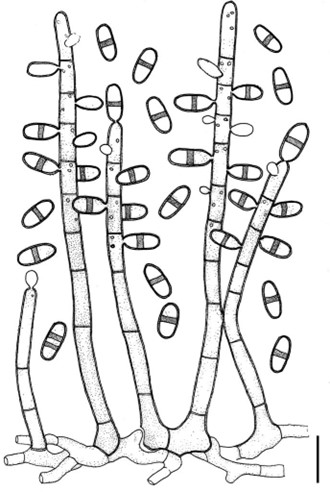Spadicoides S. Hughes, Can. J. Bot.36: 805 (1958)
MycoBank number: MB 9961; Index Fungorum number: IF 9961; Facesoffungi number: FoF 05405; 46 morphological species, 5 species with sequence data (Ma et al. 2016a, Réblová et al. 2018, Qiao et al. 2019).
= Xenospadicoides Hern.-Restr., J. Mena & Gené, Studies in Mycology 86: 92 (2017)
= Pseudodiplococcium Hern.-Restr., J. Mena & Gené, Studies in Mycology 86: 92 (2017)
Type species – Spadicoides bina (Corda) S. Hughes
Notes – Spadicoides, based on S. bina, was introduced by Hughes (1958), who regarded unbranched conidiophores as an important character to separate Spadicoides from Diplococcium (Hughes 1958). Sinclair et al. (1985) considered conidial catenation as the main character in identification between Diplococcium and Spadicoides. Shenoy et al. (2010) indicated that Spadicoides is not monophyletic and is unrelated to Diplococcium based on LSU sequence data. Réblová et al. (2018) established the sexual-asexual connection for S. bina, S. fuscolutea and S. hyalostoma, and a selenosporella-like synasexual morph was observed for S. bina and S. fuscolutea in vitro (Réblová et al. 2018). The asexual morph of Spadicoides is characterized by mononematous, unbranched or sparingly branched conidiophores, polytretic conidiogenous cells with acropleurogenus, obovoid to ellipsoid, dark brown conidia, formed singly or in a chain and selenosporella-like synasexual morphs (Goh & Hyde 1996, Ho et al. 2002, Cai et al. 2004, Réblová et al. 2018), while sexual morph has astromatic ascomata with long necks, 8-spored asci with a short pedicel and J-, apical ring and hyaline, aseptate or 1-septate ascospores (Réblová et al. 2018).

Figure 265 – Spadicoides bina, redrawn from Seifert et al. (2011). This drawing shows the conidiophores, mycelium, conidiogenous cells and conidia of S. bina. Scale bar: 10 μm.
Species
